Regarding predation, sharks are considered as ultimate predators. But all species of sharks do not tend to consume everything. They prey upon mostly sea creatures that are available in their habitat.
Now, do sharks eat snakes?
Yes, sharks eat sea snakes if they encounter each other. However, not all sharks feed on sea snakes.
Here you must know the habitat of the sea snakes, including when sharks eat them. Don’t worry. In this article, I will discuss every point in detail.
Are Sea Snakes Prey Items for Sharks?
Indeed, sea snakes are occasionally hunted by larger sharks. But for certain bottom-dwelling species like tiger sharks and sandbar sharks, these creatures serve as a staple in their diets.
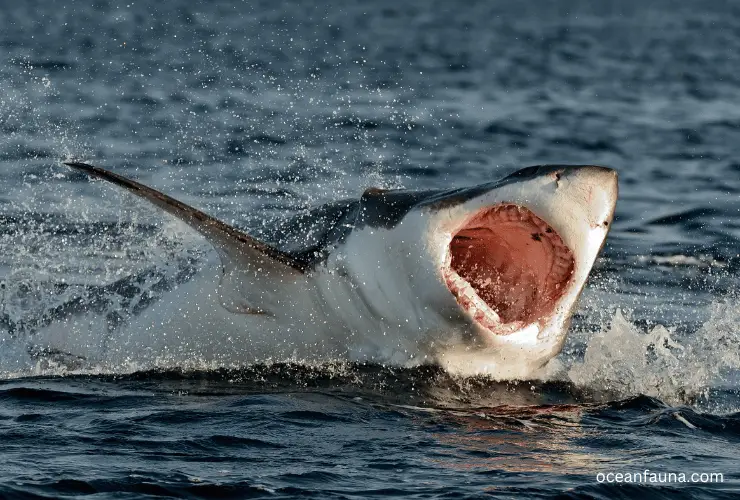
Sea snakes are found mostly in estuaries, so estuary sharks also prey upon them. Not all species of sharks feed on snakes, but those that do typically hunt them by sight and smell don’t use echolocation like they do to find other food sources. Sharks have powerful jaws and sharp teeth that allow them to bite through the snake’s scaled body for a meal.
It is not uncommon for larger sharks to hunt sea snakes. However, sea snakes have adapted over time to become more agile swimmers with flattened tails that help them manoeuvre quickly in the water and escape potential predators such as larger sharks.
How Do Sharks Prey Upon Sea Snakes?
Sharks are known to be efficient predators that use a range of hunting strategies to capture and consume their prey. Sea snakes, in particular, due to their slim bodies and streamlined shape, can prove challenging for sharks to capture.
To hunt sea snakes, sharks, especially bull sharks, will often circle their prey to gain an advantage before attacking with a sudden burst of speed. This strategy helps them corner the snake and prevent it from escaping. Once they have cornered the snake, some species of shark may bite into it or try to spin and tear it apart using their powerful jaws.
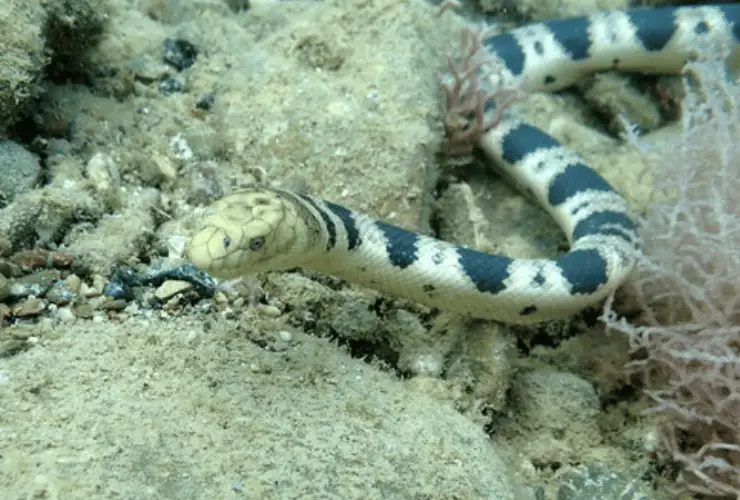
In addition to direct physical attacks, another hunting technique used by tiger sharks is lying in wait at the bottom of the ocean near coral reefs where sea snakes congregate for shelter. Sharks remain motionless until a passing snack draws close enough for an attack.
Before striking, sharks may take on an intimidating posture by raising their pectoral fins and arching their back while opening their mouth wide – this is thought to cause panic in the targeted prey, which makes them more vulnerable to predation.
Once captured, sharks use their rows of sharp teeth and powerful jaws to tear into the sea snake’s body. Depending on the species involved, some sea snakes may also be swallowed whole by large sharks such as Great White Sharks who have been known to consume prey larger than itself other sharks.
The combination of stealthy stalking techniques, lightning-fast bursts of speed, powerful jaws, and razor-sharp teeth means that sharks are incredibly effective predators when it comes to preying upon sea snakes – making them one of the most feared creatures in our oceans.
Which Sharks Eat Sea Snakes?
Some sharks consume snakes as a regular meal, while others consume them as occasional food. What are those sharks? Here are the details:
Tiger sharks
Tiger sharks are one of the main predators that regularly consume sea snakes. They are known for their large size, diverse diet and ability to adapt to various habitats. Tiger sharks inhabit all tropical and subtropical waters, including shallow coastal bays and estuaries.
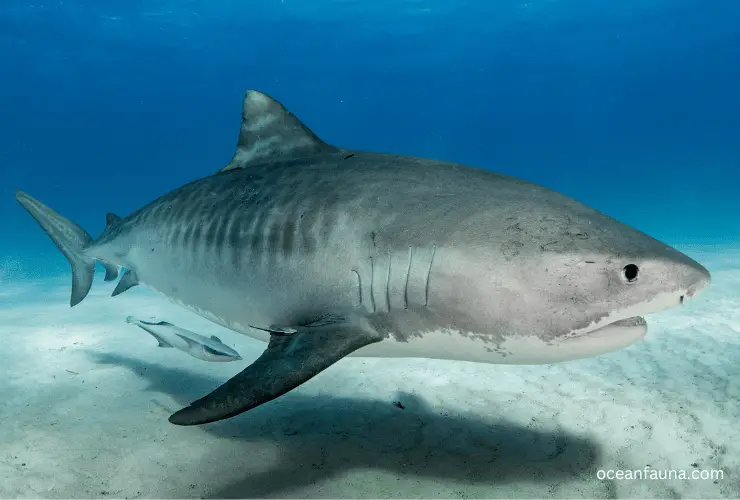
Their diet includes fish, birds, smaller sharks, turtles, crustaceans, squid, octopus and even dolphins. When it comes to sea snakes, in particular, tiger sharks are known to feed on them quite often.
Leopard sharks
Leopard sharks (Triakis semifasciata) are estuary sharks that also possess an impressive appetite that encompasses a wide variety of prey items. In addition to small fishes and invertebrates found along the sandy bottom of nearshore marine environments where they live, leopard sharks can also feast on sea snakes when they are available.
Leopard sharks inhabit temperate waters along the western coast of North America from San Francisco Bay to Baja California Sur in Mexico. Like other estuary shark species, their populations tend to fluctuate with changes in salinity levels caused by tidal cycles or human activity such as dam construction.
Sandbar sharks
Sand bar or brown shark (Carcharhinus plumbeus) is another estuary shark species that feed on sea snakes but does so only occasionally. Sand bar sharks live in tropical and warm temperate waters all over the world’s oceans, from Scotland in the north to Argentina in the south.

This includes most of the major ocean basins, like the Atlantic Ocean and the Indian Ocean, where they have been seen eating snakes near coral reefs and in shallow bays and estuaries.
The sandbar shark is a relatively large species reaching lengths up to 4 m (13 ft.). Its diet consists mostly of small teleost fishes but depending on availability this species may also feed on squid, octopuses and crustaceans. Occasionally they will also hunt cephalopods like cuttlefish or crabs. And when snakes are present, sand bars can also take advantage of this resource.
Great white sharks
Great White Sharks are one of the largest predators in the ocean and may occasionally feed on various types of sea snakes when they happen upon them while hunting other prey items.
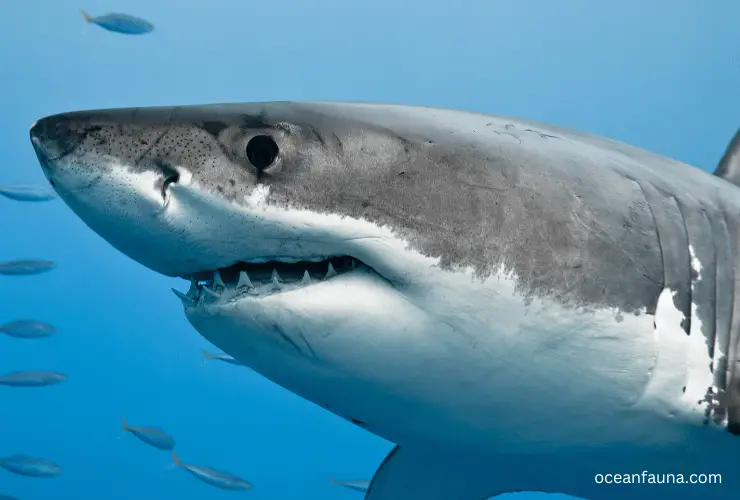
Great white sharks typically feed near the surface in open waters but do sometimes venture into more shallow coastal regions where sea snakes are more abundant.
Although great white sharks do not target these animals regularly, they will take advantage if given an easy opportunity to capture one with their powerful jaws and serrated teeth.
Bull sharks
Bull Sharks may also eat snakes from time to time when hunting for their usual prey items like smaller fish or invertebrates near shorelines or estuaries where these animals live.
Bull sharks have strong jaws filled with sharp triangular-shaped teeth, making them ideal predators for larger sea creatures such as snappers, stingrays or eels – including any unlucky snakes crossing their path.
Sharks vs Sea-Snakes: Comparative analysis
Sharks and sea snakes are two diverse yet fascinating creatures of the ocean. While both have evolved to perfectly suit their environments, the way in which these animals have adapted to the sea is very different.
Family
Sharks belong to a group called Elasmobranchii, consisting of fish with cartilaginous skeletons instead of bones.
In contrast, sea snakes belong to a group called hydrophone or “true” sea snakes, which is part of the Viperidae (venomous snake) family.
Anatomy
In terms of anatomy, sharks possess streamlined bodies with dorsal fins and a tail fin. They also have gills that allow them to breathe while they swim underwater.
Sea snakes, on the other hand, don’t have fins or gills and rely on osmotic diffusion through specialized respiratory organs called intromittent organs for breathing underwater.
Habitat
Sharks are found in almost every oceanic environment, from shallow coral reefs to deep-sea trenches. Sea snakes can only be found in tropical and subtropical marine waters such as the Indo-Pacific region and Northern Australia coasts, mangroves, and estuaries.
Diet
Both sharks and sea snakes also differ in their feeding habits: sharks are carnivorous apex predators who hunt fish, squid, and other aquatic creatures. Even some sharks consume sea snakes also (discussed above).
But, sea snakes consume small fishes and invertebrates such as eels, octopuses, and crabs.
Life span
As for lifespan, some species of shark can live up to 30 years, while most sea snake species live for around 5-10 years.
Reproduction
Sharks are oviparous animals, meaning they lay eggs outside of their bodies. However, some of the species are viviparous as well.
On the other hand, sea snakes are viviparous, meaning they give birth to live young.
A Fight Between Sharks and Sea Snakes: Who Will Win?
First, you should know that there is not enough chance of a fight between sharks and sea snakes. But if it happens, the sharks will always win due to their larger size and strength compared to sea snakes.
Not only this but they also possess an advantage in terms of speed since they have a flat body shape that allows them to swim faster than most species of sea snakes.
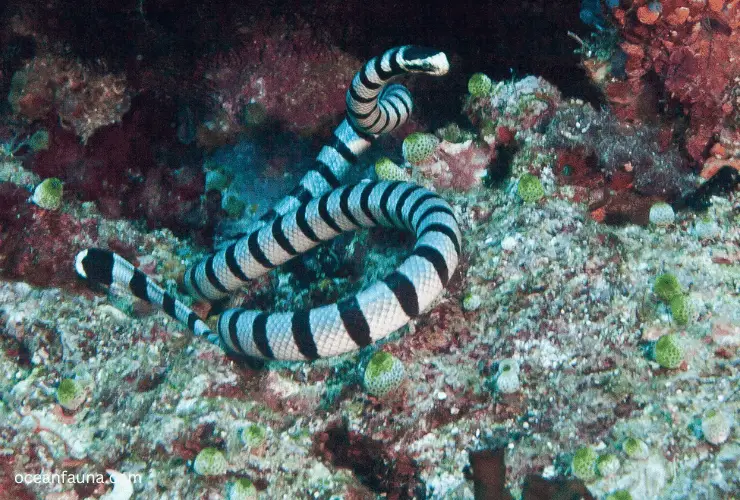
Additionally, sharks have functional gills which provide them with an oxygen supply even at depths greater than what some species of sea-snake can currently manage due to their lack of specialized organs for respiration underwater (intromittent organs).
All these combined give sharks certain advantages over sea snakes when it comes to a battle between these two aquatic predators.
Are Sea Snakes Poisonous To Sharks?
No, sea snakes are not poisonous to sharks when they eat them. Sharks have evolved over time to become immune from the venom of sea snakes. Sea snakes are a type of elapid, which contains a variety of species that produce toxins that can be deadly for humans if injected, especially in large doses.
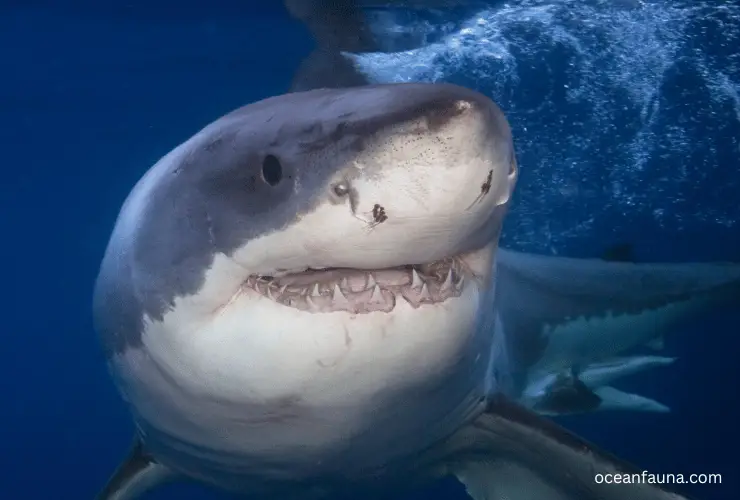
But sharks have developed an immunity to this type of toxin, unlike other animals, such as humans, who would be affected by the venom when bitten or eaten. This is because their digestive system has adapted to break down these toxins before they can cause harm.
Moreover, you already knew that some species of shark have even been known to actively seek out and consume sea snakes as part of their diet. Thus, while consuming a sea snake may not be a wise choice for humans due to its venomous nature, sharks face no danger when they feast on them.
Can A Sea Snake Bite A Shark?
A sea snake can potentially bite a shark, although it is not likely that it would be able to cause any significant damage. This is because the most venomous sea snakes have very small teeth, which are not well-suited for piercing tougher skin like a shark. Even if they were able to puncture the skin, their venom likely wouldn’t be strong enough to do much damage.
In addition, the mouth of a sea snake is not designed for holding onto prey and delivering multiple bites in succession like that of a more aggressive predator species.
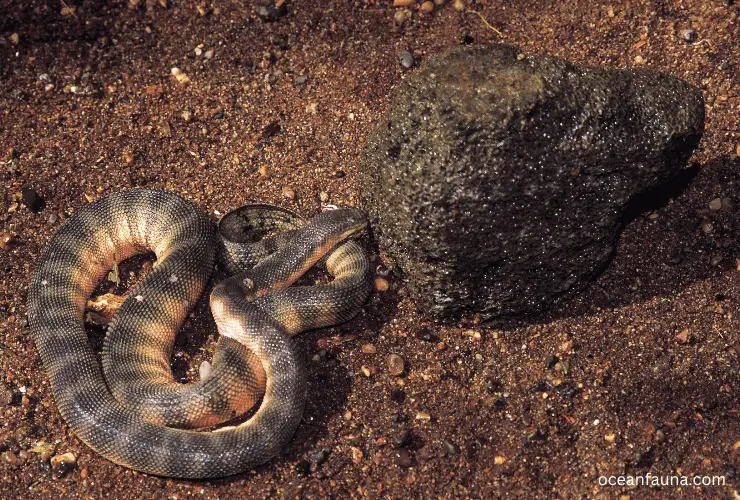
Therefore, it is unlikely that a sea snake could successfully bite and harm a shark unless it was particularly large or had extremely potent venom.
However, scientists believe that some sea snakes may use their venom as a defence mechanism against sharks or other potential predators by releasing it as part of an initial attack or as a defensive spray when being chased.
The toxins in the venom could then be absorbed through the gills, disrupting the predator’s central nervous system and eventually leading to death.
Whether this behaviour occurs in nature has yet to be observed but researchers suggest that such interference with neurological functions might explain why some accounts describe fish exploding after being attacked by snakes.
Is There Any Nutritional Benefit for Sharks Eating Sea Snakes?
Yes, there are some nutritional benefits for sharks eating sea snakes. Sea snakes are a rich source of omega-3 fatty acids and vitamins A, B6, and E, which a shark’s diet may be lacking.
Omega-3 fatty acids help sharks build strong cell membranes and guard against diseases, while the other vitamins give them additional energy. The proteins in sea snakes also provide essential amino acids that many ocean predators lack in their regular diets.
The calcium found in sea snakes helps strengthen bones and teeth for predatory fish such as sharks, which rely heavily on physical strength to survive in the wild. The phosphorus content of sea snakes helps with cell production, making it easier for the shark to repair any damage caused by predators or environmental conditions.
Sea snake meat is also a great source of important minerals such as magnesium, zinc, copper, manganese and iron. These minerals help keep metabolic processes running properly in sharks so they can hunt more efficiently and quickly repair tissue injuries sustained during fights with other predators.
Magnesium helps maintain nerve impulses, zinc boosts immunity, and copper helps form connective tissue between cells. Manganese aids in forming digestive enzymes, while iron facilitates oxygen transport throughout the body.
So, sea snake meat provides numerous nutritional benefits for sharks that would not be available from other sources in their environment.
Conclusion
So, now you know that few sharks actually eat sea snakes. The most common species are tiger sharks and two estuary sharks (leopard sharks and sandbar sharks).
However, bull sharks and great white sharks are the occasional eaters. All the sharks followed a different strategy to capture the snakes, like ambush or chase.
Finally, it’s all the parts of the marine ecosystem!

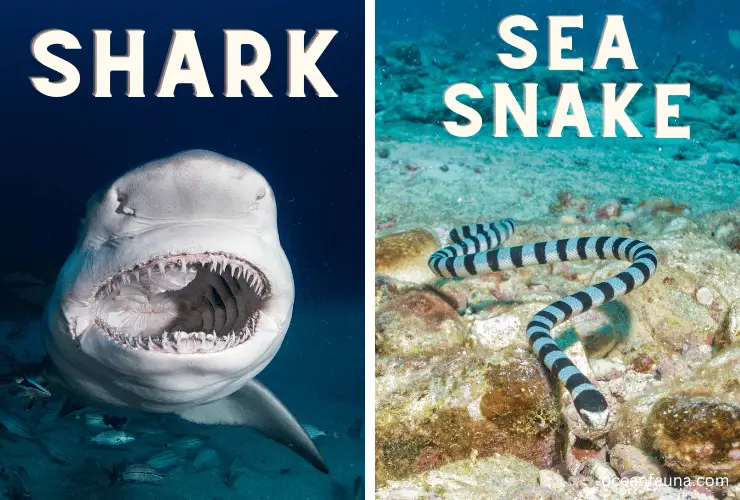
1 thought on “Do Sharks Eat Snakes? [Explained]”